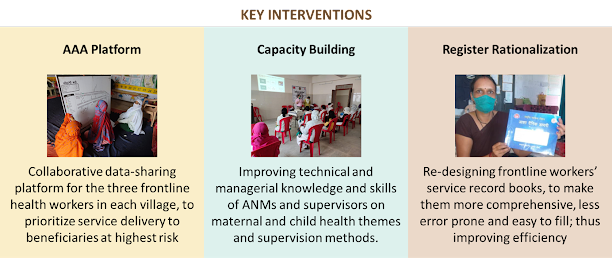


The H T Parekh Foundation (HTPF) is the philanthropic arm of HDFC Limited. The Foundation was established in October 2012 to commemorate its Founder, Shri H T Parekh’s significant contribution towards the development sector in India. HTPF have been Antara Foundation’s (TAF) partners since September 2019, supporting our work in Chhindwara district, Madhya Pradesh.Upahar Pramanik, who oversees the health portfolio at HTPF, spoke with us about the Foundation’s work and their association with TAF.
What is HTPF’s philosophy and what causes does it support?
We envision an inclusive India where vulnerable communities have equal access and opportunity to survive and thrive. Stressing on the tenets of mutual trust and respect, integrity and humility around giving, we stand as long-term supporters to our partners working to enable marginalized communities in overcoming a rangeof social issues.The Foundation works across rural and urban India and partners with organizations across the focus areas of Education, Healthcare, Livelihood and Persons with Disabilities (PwDs).
Can you tell us more about HTPF’s strategy in the healthcare sector?Our healthcare program aims to increase access to quality healthcare to vulnerable and economically marginalized women and children, with a focus on nutrition and cancer care.
Within nutrition, we aim to improve the nutritional status of adolescent girls, mothers and children, to improve key indicators such as anemia prevalence, stunting and wasting prevalence, mortality, among others. Through our implementing partners, we work on two aspects – first is access to nutrition (e.g., fortified food, supplemental food); and second is capacity building and empowerment of frontline health and nutrition workers (e.g., training programs, job aids, data-based tools). Our work on cancer focuses on improving access to early diagnosis and cancer treatment for women and children.
What were HTPF’s reasons on choosing to work in Madhya Pradesh with TAF?
HTPF looks closely at nutrition within the ‘1,000 days’ between conception and age-2, and this aligns strongly with TAF’s emphasis on designing interventions around this golden period.TAF has successfully demonstrated a model of working with frontline health and nutrition workers in Rajasthan, that was scaled up across the state. Given TAF’s subject expertise, and their proven model of scale and sustainability, we decided to work with TAF in a new large state.
With a population of approximately 85 million, Madhya Pradesh’s poor health status puts a significant burden on the country’s health outcomes. We began with a pilot study of 15 districts across the state, carried out by TAF. This pointed us to issues requiring urgent support and informed our decision to work in Madhya Pradesh.

Can you share your experience working with TAF so far?
We have had a great partnership with TAF over the last two years, and I would like to highlight five aspects that really stand out for me.
Versatility of AAA* platform: It was heartening to see village maps in Chhindwara being swiftly adapted to identify and track high-risk COVID-19 individuals (e.g., migrants, elders, people with co-morbidities) when the pandemic struck. We are happy that our investment is creating tools that can act as job-aids for frontline workers in areas that go beyond just maternal, child health and nutrition.
Buy-in of government: TAF’s impactful work in five blocks of Chhindwara convinced the district government to scale up the AAA platform across the remaining six blocks of the districts through the government supervisory system. The program team’s methodical and data-driven approach to work, as well as the real-time monitoring of impact were key factors behind this.
On ground transformation: In my field visit last year, frontline workers revealed how things stood few months back – populations being missed out, poor identification of critical beneficiaries, data mismatch, and so on. I was amazed by the changes after TAF’s program. The interventions not only enabled teamwork and better use of data, but also increased efficiency and motivation.

Photo:Upahar interacting with frontline workers
ASHA diary scale-up:Rationalizing the ASHA Diary (her service record book) was a key intervention that was accepted by the state in Aug 2020 for state-wide scale-up through the government system, to benefit more than 77,000 ASHAs across all 52 districts. While most field activities were halted during the lockdown, it was impressive how the TAF team utilized this time to simplify and re-design the ASHA diary in close collaboration with state and district officials, supervisors and ASHAs.
Gateway for new partnerships:With a strong belief in the model, we entered a completely new geography with TAF. It gives me great pride to see our partnership being instrumental in mobilizing new supporters for TAF to expand into additional districts and further their mission to scale.
How do you see your partnership with TAF going forward?
In a year’s time, we would have completed three years of a fruitful partnership. We are already seeing early outcomes, great acceptance from government and a clear pathway towards scale. It is a good time to reflect on aspects such as sustainability, and how we can institutionalize interventions within the health system. At the same time, we must start thinking of an independent evaluation to measure and establish the great impact emanating from the program. We hope to partner with TAF in designing and working on some of these aspects.

*AAA refers to the three frontline health workers present in each village in India – the Auxiliary Nurse Midwife (ANM), the Accredited Social Health Activist (ASHA) and the Anganwadi worker.